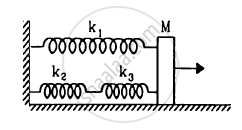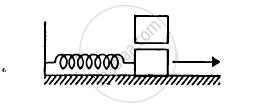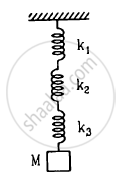Advertisements
Advertisements
Question
The equation of motion of a particle started at t = 0 is given by x = 5 sin (20t + π/3), where x is in centimetre and t in second. When does the particle
(a) first come to rest
(b) first have zero acceleration
(c) first have maximum speed?
Solution
Given:
The equation of motion of a particle executing S.H.M. is,
\[x = 5 \sin \left( 20t + \frac{\pi}{3} \right)\]
The general equation of S..H.M. is give by,
\[x = A \sin (\omega t + \phi)\]
(a) Maximum displacement from the mean position is equal to the amplitude of the particle.
As the velocity of the particle is zero at extreme position, it is at rest.
\[\therefore \text { Displacement }\] x = 5, which is also the amplitude of the particle.
\[\Rightarrow 5 = 5 \sin \left( 20t + \frac{\pi}{3} \right)\]
\[\text { Now }, \]
\[ \sin \left( 20t + \frac{\pi}{3} \right) = 1 = \sin\frac{\pi}{2}\]
\[ \Rightarrow 20t + \frac{\pi}{3} = \frac{\pi}{2}\]
\[ \Rightarrow t = \frac{\pi}{120} s\]
The particle will come to rest at \[\frac{\pi}{120} s\]
(b) Acceleration is given as,
a = ω2x
\[= \omega^2 \left[ 5 \sin \left( 20t + \frac{\pi}{3} \right) \right]\]
For a = 0,
\[5 \sin \left( 20t + \frac{\pi}{3} \right) = 0\]
\[ \Rightarrow \sin \left( 20t + \frac{\pi}{3} \right) = \sin \pi\]
\[ \Rightarrow 20t = \pi - \frac{\pi}{3} = \frac{2\pi}{3}\]
\[ \Rightarrow t = \frac{\pi}{30} s\]
\[\cos \left( 20t + \frac{\pi}{3} \right) = - 1 = \cos \pi\]
\[ \Rightarrow 20t = \pi - \frac{\pi}{3} = \frac{2\pi}{3}\]
\[ \Rightarrow t = \frac{\pi}{30} s\]
APPEARS IN
RELATED QUESTIONS
A particle executes simple harmonic motion with an amplitude of 10 cm. At what distance from the mean position are the kinetic and potential energies equal?
A particle having mass 10 g oscillates according to the equation x = (2.0 cm) sin [(100 s−1)t + π/6]. Find (a) the amplitude, the time period and the spring constant. (c) the position, the velocity and the acceleration at t = 0.
Consider a particle moving in simple harmonic motion according to the equation x = 2.0 cos (50 πt + tan−1 0.75) where x is in centimetre and t in second. The motion is started at t = 0. (a) When does the particle come to rest for the first time? (b) When does he acceleration have its maximum magnitude for the first time? (c) When does the particle come to rest for the second time ?
The pendulum of a clock is replaced by a spring-mass system with the spring having spring constant 0.1 N/m. What mass should be attached to the spring?
The block of mass m1 shown in figure is fastened to the spring and the block of mass m2 is placed against it. (a) Find the compression of the spring in the equilibrium position. (b) The blocks are pushed a further distance (2/k) (m1 + m2)g sin θ against the spring and released. Find the position where the two blocks separate. (c) What is the common speed of blocks at the time of separation?

Repeat the previous exercise if the angle between each pair of springs is 120° initially.
The springs shown in the figure are all unstretched in the beginning when a man starts pulling the block. The man exerts a constant force F on the block. Find the amplitude and the frequency of the motion of the block.

Solve the previous problem if the pulley has a moment of inertia I about its axis and the string does not slip over it.
A 1 kg block is executing simple harmonic motion of amplitude 0.1 m on a smooth horizontal surface under the restoring force of a spring of spring constant 100 N/m. A block of mass 3 kg is gently placed on it at the instant it passes through the mean position. Assuming that the two blocks move together, find the frequency and the amplitude of the motion.

Find the elastic potential energy stored in each spring shown in figure when the block is in equilibrium. Also find the time period of vertical oscillation of the block.

Discuss in detail the energy in simple harmonic motion.
When a particle executing S.H.M oscillates with a frequency v, then the kinetic energy of the particle?
If a body is executing simple harmonic motion and its current displacements is `sqrt3/2` times the amplitude from its mean position, then the ratio between potential energy and kinetic energy is:
Displacement versus time curve for a particle executing S.H.M. is shown in figure. Identify the points marked at which (i) velocity of the oscillator is zero, (ii) speed of the oscillator is maximum.

Draw a graph to show the variation of P.E., K.E. and total energy of a simple harmonic oscillator with displacement.
Find the displacement of a simple harmonic oscillator at which its P.E. is half of the maximum energy of the oscillator.
A body of mass m is attached to one end of a massless spring which is suspended vertically from a fixed point. The mass is held in hand so that the spring is neither stretched nor compressed. Suddenly the support of the hand is removed. The lowest position attained by the mass during oscillation is 4 cm below the point, where it was held in hand.
What is the amplitude of oscillation?
The total energy of a particle, executing simple harmonic motion is ______.
where x is the displacement from the mean position, hence total energy is independent of x.
